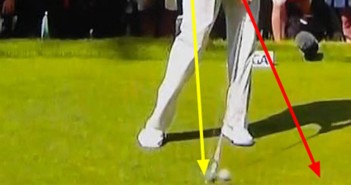There are about as many ways of successfully swinging a golf club as there are professionals on tour, every player is unique, so how can there be one optimal swing method?
Of course we’re all unique, but (unless we have a major disability or injury), we all have broadly the same bones, joints, muscles and tendons. Our bodies are designed to work in the same way.
A common argument against the existence of an optimal swing is that we all walk differently, with different gaits based on our build, so surely we will all swing a golf club differently? It’s true that every individual has a unique gait pattern, but it’s also true that there is a most efficient gait pattern, and that physical therapists use an optimal model to address problems and help people develop a more efficient gait, resulting in decreased risk of injury, less energy expenditure, and improved muscular balance.
This becomes clear when you extrapolate up to sprinting — when you watch the Olympic 100 metres final, how many different styles of sprinting do you see? Sprinting isn’t golf, but it’s a complex athletic movement in which inefficiencies are clearly and quickly exposed, and where (unlike golf, until now) science has been used to develop an optimal model movement pattern that is used by all elite contestants to improve their performance.
Sports biomechanics tells us that there is only one way to move the human body, as it was designed to function, so as to most effectively swing a golf club in order to send the golf ball to the target powerfully, accurately and consistently.
Yes, we are all built slightly differently. Some of us have longer arms, smaller hands, broader chests etc. That’s why Golf Loopy does not talk much in terms of specific distances or angles. And when we do talk about positions, they are described relative to the relevant parts of your own body, whatever your shape and build.
Yes, you can play at the highest levels with an imperfect swing — every tour professional does! Tour professionals can do this because they’ve practised a huge amount, and they have extraordinary athletic ability — the only way that they can get away with their inefficient and extraneous movements is through great timing and coordination. Because of this, most of them are inconsistent and suffer from a myriad of golf-related injuries. Yes, they’re a lot more consistent than amateur golfers, but they can rarely maintain their best golf for a month, a year, a career… no matter how good they are and how much they practise. And for you to learn to swing exactly like any given professional would be ineffective, you’d need to learn not only the good movements, but also exactly the same compensations and manipulations which stitch it all together and cause that golfer problems.
We will teach you the ideal way to move your body to hit great golf shots every time.
At every level, golf gets a lot easier when you reduce complexity in your swing, when you rely less on timing, and when you use your body as efficiently and safely as possible.
The most effective golf swing will enable you to consistently lower your scores, win more tournaments, and enjoy the game more.
The key characteristics of the optimal golf swing are:
- Efficient and Powerful — The optimal swing must enable you to use your body in the most efficient way possible for the creation, storage, transmission and application of energy to the golf ball. It should also enable you to leverage your athleticism — if you’re fitter and stronger than the other guy, then that should show on the course. If you’re not particularly athletic, you should still be able to make the most of what you have by swinging the golf club with maximum efficiency. It’s a lot easier to get close to the pin with your second shot on a long par-4 if you’ve got a wedge in your hand instead of a 5-iron.
- Accurate — The optimal swing needs to enable you to hit the golf ball the right distance, in the right direction, to your chosen target. It’s no good hitting the ball a long way if you hit it into trouble. The more accurately you can play golf, the more fairways you’ll find, the more greens in regulation you’ll hit, and the shorter your putts will be.
- Reliable, Repeatable and Consistent — We all make mistakes, but the optimal golf swing will minimise the frequency and severity of your errors, and will stand up under pressure. Hitting the golf ball long and straight is great, but to lower your scores and win tournaments you need a swing that you can rely on, week in week out.
- Simple — The optimal golf swing will have the minimum number of moving parts, and the smallest, simplest movements possible while still meeting the other criteria listed here. While there is an optimal golf swing, no one can perform perfectly every time, and any unnecessary movement will complicate the golf swing and make it easier to make mistakes, and so to introduce additional compensations and manipulations that lead to inconsistency.
- Learnable — For a golf swing pattern to be useful, golfers must be able to learn it. The optimal golf swing can be learned by every golfer who is physically able — no matter what their experience, age, current skill level or athletic ability.
- Scalable — The optimal golf swing will enable you to continue to learn and to improve to the maximum skill level that you are able to attain. If you learn the optimal golf swing as a beginner, you shouldn’t have to unlearn or replace movements as you improve, right up until the highest levels of the game. If you have the dedication and the athletic ability then the sky is the limit, the optimal golf swing will support and enable you, not hold you back.
- Workable — While the optimal golf swing will enable you to strike the ball beautifully, hitting it straight and true every time (and it will also give you a “go to” shot that you can rely on under difficult conditions), it should also enable you to work the ball — to hit a fade, a draw, hit it high or low — when you want to. A truly great golf swing will enable you to be play aggressively when you want to, to take on long dog-leg par-5s, shape the ball around obstacles, and attack difficult pin positions. It will free up your creativity.
- Manageable — We all have bad days, when our body doesn’t perform as well it usually does, when mistakes creep in and we hit bad shots. The optimal golf swing should enable you to identify your errors, recognise the root causes and quickly fix them — both on the practice range and out on the course.
- Safe — Most of all, the optimal golf swing must be kind to your body. The golf swing generates enormous forces, and undue stresses and strains will cause discomfort and potentially serious injuries. The optimal golf swing will eliminate discomfort and prevent almost every golf-related injury. You will play better, enjoy this great game a whole lot more, and play for longer.
If you have any questions or comments about this or other articles on Golf Loopy, please send us an email.
Next, a look at why traditional golf instruction doesn’t work, in Why Most Amateurs Suck at Golf.




